| Pages:
1
2
3
4
5
..
9 |
aga
Forum Drunkard
    
Posts: 7030
Registered: 25-3-2014
Member Is Offline
|
|
The CPU chip resisted more. Firstly there was some copper colour appearing, then the legs went black where the Gold had dissolved :-
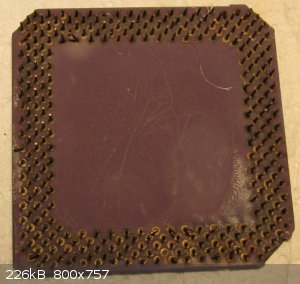
A quick attempt was made to precipitate some gold using (left to right)
NaOH
3% H2O2
Fresh Filtered Lemon Juice (smells wonderful)
Sodium Metabisulphite (loads and loads of it)
Not much joy really, but then, the quantity of Gold here is infinitessimally small.
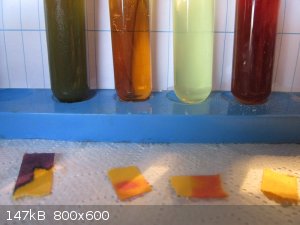
Only the NaOH-treated solution has some suspended solids.
Will wait a while to see if they settle.
|
|
|
deltaH
Dangerous source of unreferenced speculation
    
Posts: 1663
Registered: 30-9-2013
Location: South Africa
Member Is Offline
Mood: Heavily protonated
|
|
Colloidal gold!!! Gold nanoparticles!!!
https://en.wikipedia.org/wiki/Colloidal_gold
The last one is typical.
[Edited on 18-9-2015 by deltaH]
|
|
|
Little_Ghost_again
National Hazard
   
Posts: 985
Registered: 16-9-2014
Member Is Offline
Mood: Baffled
|
|
TUT TUT I can see gold left on that chip  , maximise your profit aga , maximise your profit aga  , so how do we go about getting the copper back? , so how do we go about getting the copper back?
Dont ask me, I only know enough to be dangerous
|
|
|
deltaH
Dangerous source of unreferenced speculation
    
Posts: 1663
Registered: 30-9-2013
Location: South Africa
Member Is Offline
Mood: Heavily protonated
|
|
Iron should do the job as kadriver showed on his tailings pot video.
[Edited on 18-9-2015 by deltaH]
|
|
|
aga
Forum Drunkard
    
Posts: 7030
Registered: 25-3-2014
Member Is Offline
|
|
Sorry.Very lax indeed.
I was a bit excited, seeing as it was a World First in the Entire Human History of Gold Refinery.
The notion of getting it 100% right before posting the preliminary results slipped my mind (such as it is).
|
|
|
Little_Ghost_again
National Hazard
   
Posts: 985
Registered: 16-9-2014
Member Is Offline
Mood: Baffled
|
|
Quote: Originally posted by aga  |
Sorry.Very lax indeed.
I was a bit excited, seeing as it was a World First in the Entire Human History of Gold Refinery.
The notion of getting it 100% right before posting the preliminary results slipped my mind (such as it is). |
Ok I will let you off this time! Yes it is very exciting, it would sure be a biggy if it changed how it was done on an industrial level.
I am playing with temperature as well at the moment and NO hydrogen peroxide. I will post an update as soon as anything happens
Dont ask me, I only know enough to be dangerous
|
|
|
aga
Forum Drunkard
    
Posts: 7030
Registered: 25-3-2014
Member Is Offline
|
|
Cool !
Photos please of the Nitrogen Oxide Hydrogen Peroxide compound.
Even a ball-and-stick model would be fantastic 
|
|
|
Little_Ghost_again
National Hazard
   
Posts: 985
Registered: 16-9-2014
Member Is Offline
Mood: Baffled
|
|
There you go
I think the ball and stick model is something like this

Dont ask me, I only know enough to be dangerous
|
|
|
aga
Forum Drunkard
    
Posts: 7030
Registered: 25-3-2014
Member Is Offline
|
|
LOL !
One day LG2.759 you shall do some actual chemistry.
Until then, carry on regardless !
[Edited on 18-9-2015 by aga]
Actually, you made a good point.
I will go and chuck various stuff into a deltaH solution and see what happens.
Lead, Tin, Copper and stuff.
[Edited on 18-9-2015 by aga]
|
|
|
Little_Ghost_again
National Hazard
   
Posts: 985
Registered: 16-9-2014
Member Is Offline
Mood: Baffled
|
|
Have a look at this
www.mdpi.com/1996-1944/7/6/4555/pd
There is a right mix in some boards, the main problem (UK perspective) is we class older boards as toxic waste because they contain heavy metals and
lead. now if we can find a way to recover those then what we are left with is the fiber glass bit, looking around it seems on the bigger scale boards
are powdered up then refined to recover the metals.
This has me thinking about the left over fiber board powder, I am wondering if it would make a good additive in cement. Maybe if enough could be added
it would make normal cement more insulating?
Dont get me wrong the gold recovery is a big thing, but you have a clean way to get the copper and gold so why not see if you can get the others? As
mad as it sounds this could all end up really useful, especially if we can find a way to speed it up a little.
I do some chemistry but mostly things go wrong so I keep quiet about it  . .
So how do we go about tidying up these results? I will see if I can find out whats in the AMD processor metal wise, any idea what chip it was?
Dont ask me, I only know enough to be dangerous
|
|
|
aga
Forum Drunkard
    
Posts: 7030
Registered: 25-3-2014
Member Is Offline
|
|
Fibreglass regularly finds it's way into Concrete as an alternative to Steel.
Costs more than the Concrete weight for weight.
Failed experiments tell us a lot more than those that succeed ...
|
|
|
Little_Ghost_again
National Hazard
   
Posts: 985
Registered: 16-9-2014
Member Is Offline
Mood: Baffled
|
|
if it costs more than weight for weight then that makes it worth recovering if your doing it on a large scale?
I know we are looking at gold recovery but I stumble on a page that gives some examples of rare older processors that are worth a fortune intact. It
also mentions that the pentium pro processor contains the most gold (processor wise) with around 1g per processor.
I got kinda bogged down at hat point after finding this
http://micro.magnet.fsu.edu/creatures/index.html
It appears that some manufactures had designers that hid little pictures made of gold inside chips, that page is a gallery of some
Dont ask me, I only know enough to be dangerous
|
|
|
aga
Forum Drunkard
    
Posts: 7030
Registered: 25-3-2014
Member Is Offline
|
|
Well, you can spend your life looking for Gold if you like.
Not a lot of point in the end.
Better spend your limited time enjoying yourself rather than searching for Riches unattainable.
|
|
|
Little_Ghost_again
National Hazard
   
Posts: 985
Registered: 16-9-2014
Member Is Offline
Mood: Baffled
|
|
Pk a more serious topic.
Time for a word of caution, I have been breaking up some old boards with a hammer. These are a mix of very old and some newer boards I have kept for
spare parts off them. In gold fever I was happily bashing away to crack open the goodies etc and pounded on a metal box on the board, BIG mistake.
What I smashes open turned out to be a mercury wetted relay! So now I have mercury splashed all about the place and on my jeans  , this got me thinking about possible reactions with stuff like mercury and Tantalum
bead caps etc. , this got me thinking about possible reactions with stuff like mercury and Tantalum
bead caps etc.
Might be an idea to have a think of some of the other things on boards we might come up against, Tantalum is pretty common on boards so any idea if it
will react with this method? and if so is it anything to worry about? Now I got to go and try and find small bits of mercury!! Its more a warning to
lurkers who might be trying to give this a go, there seemed to be a fair bit of mercury inside the relay. I have some more of these relays on another
board, I will desolder them before I smash the board
Dont ask me, I only know enough to be dangerous
|
|
|
aga
Forum Drunkard
    
Posts: 7030
Registered: 25-3-2014
Member Is Offline
|
|
Wow!
How Lucky art thou ?!?!
To get hit with a mere splash of the tiny amount of mercury in a wetted relay and then to notice the fraction of 0.01g of anything hitting your jeans
!
The Lord is Surely With Thou, O LG2.801
Better bullshit please. Drink less and remember where you are.
|
|
|
Little_Ghost_again
National Hazard
   
Posts: 985
Registered: 16-9-2014
Member Is Offline
Mood: Baffled
|
|
Hmm Time for pic and a datasheet  BRB BRB
Dont ask me, I only know enough to be dangerous
|
|
|
Little_Ghost_again
National Hazard
   
Posts: 985
Registered: 16-9-2014
Member Is Offline
Mood: Baffled
|
|
Couldnt find a sheet but here is a pic
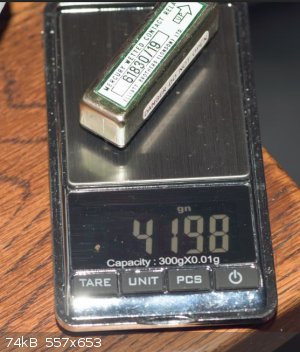
I had scales on wrong read out but its 27 grams, if you shake it then you can hear it move about inside, I would roughly guess twice a normal lab
thermometer worth inside.
If you can hold off until tomorrow so I can get some sulphur I will Dremel the sucker open and weigh the mercury. But its sure as hell alot more than
your thinking!
Oh and I dont drink  I seen what it does to others I seen what it does to others 
[Edited on 18-9-2015 by Little_Ghost_again]
Dont ask me, I only know enough to be dangerous
|
|
|
aga
Forum Drunkard
    
Posts: 7030
Registered: 25-3-2014
Member Is Offline
|
|
I stand corrected.
If you can hear it sloshing about, then there's certainly enough mercury in there worth recovering, and you should spin that process off in another
thread.
|
|
|
aga
Forum Drunkard
    
Posts: 7030
Registered: 25-3-2014
Member Is Offline
|
|
Having left the test tube samples overnight, the one with NaOH has developed a dark black-green lower layer and the one with sodium metabisulphite has
a spongy reddish precipitate lying on top of undissolved bisulphite.
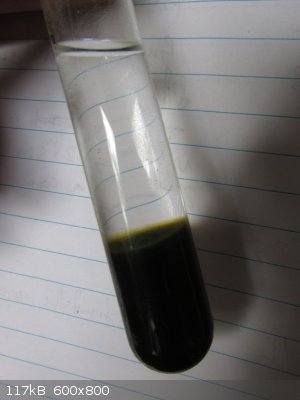 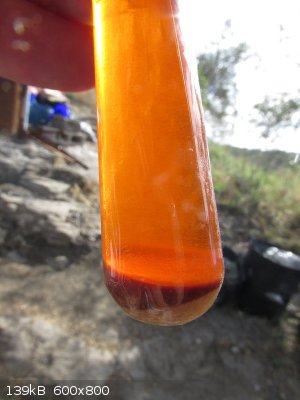
|
|
|
Little_Ghost_again
National Hazard
   
Posts: 985
Registered: 16-9-2014
Member Is Offline
Mood: Baffled
|
|
Thats really interesting, I know this sounds stupid but. I know that there is a gold test where if the gold isnt great it turns like the colour of the
NAOH one.
Is it possible/likely the NAOH one picked up some copper from the AMD chip? Not sure what I am thinking at the moment
[Edited on 19-9-2015 by Little_Ghost_again]
Dont ask me, I only know enough to be dangerous
|
|
|
deltaH
Dangerous source of unreferenced speculation
    
Posts: 1663
Registered: 30-9-2013
Location: South Africa
Member Is Offline
Mood: Heavily protonated
|
|
As I suspected, there is very little that is 'new' these days. I had a look in on a site goldrefiningforum.com. It requires one to register to search,
but low and behold, there is a thread from 2013 on "pin foils with vinegar, peroxide, and salt" 
Seems they suspect the same as what we discussed, Cu(II) is doing the etching and reducing to Cu(I) which is then re-oxidised by an oxidant (air or
peroxide).
Similarly, from 2014, "bleach, vinegar and salt dissolve gold"
It easy to reinvent the wheel these days 
With such knowledge out there, I wonder why its use hasn't been more common place?
*****
A word on recovery of the gold from solution post dissolution. In industry, activated carbon is used to adsorb gold from cyanide solutions. Called the
'carbon in pulp process' if I'm not mistaken.
I wonder if that might not be applied instead of reducing agents. Granulated activated carbon is very cheap and will mop up even dilute solutions
nicely.
Activated carbon manufacturers have special grades of carbons specifically optimised for removing gold from solution, so if one is inclined to do this
on a larger scale, it's maybe worthwhile to procure a bag of this from them.
[Edited on 20-9-2015 by deltaH]
|
|
|
Little_Ghost_again
National Hazard
   
Posts: 985
Registered: 16-9-2014
Member Is Offline
Mood: Baffled
|
|
Quote: Originally posted by deltaH  | As I suspected, there is very little that is 'new' these days. I had a look in on a site goldrefiningforum.com. It requires one to register to search,
but low and behold, there is a thread from 2013 on "pin foils with vinegar, peroxide, and salt" 
Seems they suspect the same as what we discussed, Cu(II) is doing the etching and reducing to Cu(I) which is then re-oxidised by an oxidant (air or
peroxide).
Similarly, from 2014, "bleach, vinegar and salt dissolve gold"
It easy to reinvent the wheel these days 
With such knowledge out there, I wonder why its use hasn't been more common place?
*****
A word on recovery of the gold from solution post dissolution. In industry, activated carbon is used to adsorb gold from cyanide solutions. Called the
'carbon in pulp process' if I'm not mistaken.
I wonder if that might not be applied instead of reducing agents. Granulated activated carbon is very cheap and will mop up even dilute solutions
nicely.
Activated carbon manufacturers have special grades of carbons specifically optimised for removing gold from solution, so if one is inclined to do this
on a larger scale, it's maybe worthwhile to procure a bag of this from them.
[Edited on 20-9-2015 by deltaH] |
My guess would be time is the factor that limits the uptake of this method, few in the industry seem bothered about waste and want to reclaim as fast
as possible, but I doubt they have worked out the cost factor of materials in this.
Personally I think this line is well worth pursuing, especially with the other thread on lead and tin etc.
LG
Dont ask me, I only know enough to be dangerous
|
|
|
kadriver
Hazard to Others
  
Posts: 196
Registered: 7-11-2012
Location: United States
Member Is Offline
Mood: Thankful
|
|
I am a member of the GRF and I have never seen the post for vinegar salt and peroxide.
Neat to know that the bleach will dissolve the foils.
Aga, keep in mind that I had 500 grams of fingers, and only got 1 gram of gold.
Also, see my new video on stripping gold off gold plated items with an electrolytic cell. In part 2, when I added the SMB, nothing happened (because
there was such a small quantity if gold in solution).
With such a small quantity of gold in solution - less than 1 gram per liter - the gold precipitates and settles very slowly.
It did ppt and settle after sitting over night - see the video, end of part 2.
Anyway, I started the scale up experiment this evening.
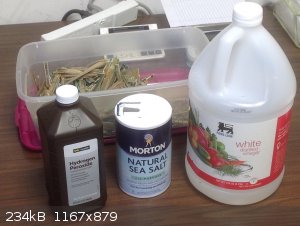
|
|
|
kadriver
Hazard to Others
  
Posts: 196
Registered: 7-11-2012
Location: United States
Member Is Offline
Mood: Thankful
|
|
Here is the fingers being aerated in a solution of 2 liters of white vinegar, 235 grams of sea salt, and 100ml hydrogen peroxide. I started the
experiment at 10:30pm on Tues 22 Sep 2015.
Here is a picture of the experiment immediately after starting.
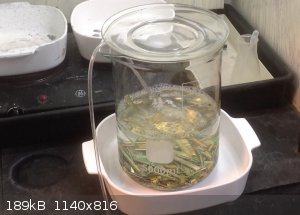
|
|
|
kadriver
Hazard to Others
  
Posts: 196
Registered: 7-11-2012
Location: United States
Member Is Offline
Mood: Thankful
|
|
Then went to take a shower and when I came back 1/2 hour later the solution had already begun to turn blue from the copper dissolving.
I am also doing a video documentary of the entire process. It should be ready to publish in a few days.
What a great thing to be able to do, even though it's already been done on the GRF.
I just wish that these videos were around back when I was learning how to do all this.
kadriver
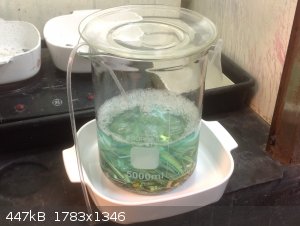
|
|
|
| Pages:
1
2
3
4
5
..
9 |